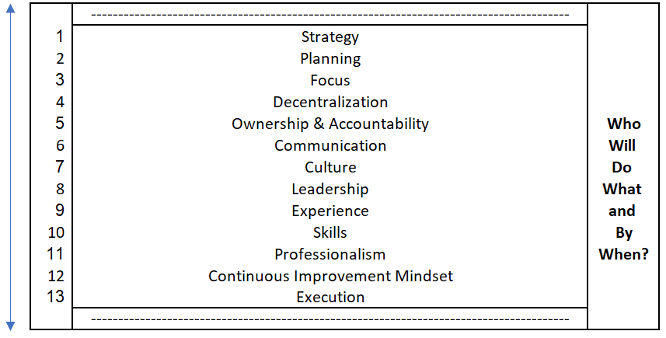There are probably a lot of tips and learnings you have picked up as you went...
"Strategy is the great work of the organisation… it is a unifying theme that gives coherence and direction to the actions and direction of an organisation." - Sun Tzu, The Art of War
What Is Strategy Execution?
The best approach to creating a sustainable company is to build a strategy. A strategy is designed by identifying a unique offering and ensuring operational excellence and execution aided by support activities throughout the value chain. As we understand from HBR's Michael Porter, strategy is a system of activities where Fit between these components is central.
Strategy execution means core competencies support a realistic strategy and that the plan can be achieved, on time, on budget, and with the intended results. In all honesty, there is no good strategy and failed execution. If an organisation is unaware of its core capabilities and limitations and moves forward anyway, the strategy is flawed.
It helps to think of strategy & execution in this way:
- Strategy without execution is a boat paddling with a clear sense of direction but manned by a crew who doesn't know how to or can't row the boat.
- Execution without a strategy is akin to a boat paddling quickly but spinning in circles and going nowhere fast.
- Strategy-execution and Fit are akin to an Olympic rowing team, where leadership provides clear direction, and the crew is individually strong and competent.

GSD - The No-Nonsense Framework for Closing the Strategy-Execution Gap
How Business Partners Support Strategy Execution
Those in business partnering roles have a unique and valuable role in supporting both strategy and execution in their organisations. The business partner is critical to ensuring a realistic strategy is on track.
Business partnering roles support the highest leadership levels of an organisation and have accessibility and visibility into the horizontal and vertical layers of the organisation. They quickly and accurately assess core competencies and track progress to targets from this viewpoint.
Business partners are vital in communicating the strategy across the organisation to build trust and buy-in while ensuring functions are focused on critical activities. In addition, business partners ensure valuable resources are aligned to common goals.

Strategy Execution Gap- GSD- The No-Nonsense Framework for Closing the Strategy-Execution Gap
Ensuring Alignment Across the Organisation
Maintaining a close link between strategy and execution is critical. Essentially, your strategy is your promise to deliver value:
- to customers,
- now and in the future,
- in a way no other company can.
Strategy execution occurs in the thousands of decisions made each day by people at every level of your company. The stronger the cross-functional dynamics and the more it is supported by its culture, the more effective strategy execution.
Unfortunately, too many organisations unintentionally diminish their capabilities by allowing functions to operate independently. It's often easier for functional leaders to focus on "doing my job better" rather than on "what we can accomplish together."
- When pressed for time, executives delegate execution to operational managers, focused on their areas of expertise, instead of the whole organisation's overall direction.
- A lack of collaboration to bring together people leads to misunderstandings, distrust, and ultimately pursuing competing objectives and agendas.
- Narrow priorities conflict, and teams end up stuck in cycles of internal competition.
- The larger an organisation gets, the more challenging it becomes to resolve these problems.
Here is where business partners can support strategy execution and ensure alignment across the organisation.
One of the most valuable aspects of business partnering is the ability of the role to work cross-functionally. One day they can work with supply chain and procurement, and the next with HR and the executive team. This accessibility and visibility provide real-time insights into the progress of strategy execution by transcending functional barriers.
- Business partners add value by identifying obstacles to strategy execution area by area.
- The business partner determines strategy support and execution progress by walking around, observing business activities, and
- Engaging in conversations with individuals at different levels.
As needed, they can quickly escalate and collaboratively resolve issues to get alignment back on track.

Strategy Execution Framework- GSD- The No-Nonsense Framework for Closing the Strategy-Execution Gap
Validating Core Competencies Supporting Strategy
An organisation's core set of competencies is essential to achieving its strategy. It's not enough to get one or two competencies right-linkage between those and strategy is crucial. Thus, Fit occurs when the strategy and core competencies are aligned.
Fit is challenging for competitors to imitate and is the path to sustainable long-term profitability. The strategy-execution gap occurs when Fit is lost. A disconnect forms between strategy and execution when the people closest to the work don't know what the strategy is and what they must do to help achieve it.
Business partners support strategy execution by supporting cross-functional teams to identify, build, and grow key capabilities. They ensure core capabilities have the funding and leadership support to maintain their edge. Business partners then monitor key capabilities and hold others accountable for fully developing the capacity.
Execution is inherently complex because:
- Poor planning leads to projects not being completed on time.
- Lack of organisation does not dictate who does what and by when to connect goals to day-to-day responsibilities.
- A lack of autonomy and ownership prevents workers from adapting, as needed.
Left alone, complexity creeps back in, along with the associated costs and bureaucracy. Business partners can be deployed to ensure the organisation sticks with saying "no" to activities that do not support the strategy. Business partners ensure focus and finances support the core competencies that matter.
Implementing Metrics
Implementing metrics is not a new idea for organisations. However, ensuring progress on strategy tied to goals and objectives supported by metrics that matter is. Today, organisations are flooded by metrics of all sorts-this leads to a loss of focus and loss of Sense of Urgency when metrics turn red.
Business partners can support strategy execution by:
- Adopting the Pareto Principle to identify, set, and monitor the few metrics that genuinely matter daily, weekly, and monthly.
- Keeping metrics limited to those that are simple yet impactful.
As deviations occur from targets, conversations and investigations can begin almost immediately to understand what has gone off-track, why, how to fix it, and how to ensure it doesn't happen again.
Establishing Ownership for Results
Communicating expectations for performance is integral to achieving goals. Among the more challenging aspects of this skill is holding people accountable for achieving their business goals.
Business partners can ensure that barriers to performance are being addressed and ensure those working on crucial challenges have the necessary resources, support, and motivation to meet their goals.
- Business partners can advocate for the organisation to grant employees greater authority and responsibility in performing their work. This goes far toward building an ownership culture.
- Empowered employees feel more motivated to solve customer problems and develop innovative ideas for improving their business areas.
- In return, employees feel more accountable for long-term organisational outcomes and are more likely to increase their equity stakes.
When we think of accountability, we typically think of holding others accountable. But the most influential leaders and best business partners serve as role models by holding themselves accountable by exhibiting ownership and accountability. The locus of control shifts from outside to inside.
Unless employees have incentives to implement the strategy, they will likely not commit to it, and the implementation will fail.
Conclusion
Business partners must play a crucial role in supporting strategy execution.
By first understanding the strategy, they can work collaboratively to ensure alignment between people, processes, and systems supported by core competencies to maintain Fit. Business partners should influence the organisation to instill ownership of objectives and track progress through critical metrics.
Subscribe to
FP&A Trends Digest

We will regularly update you on the latest trends and developments in FP&A. Take the opportunity to have articles written by finance thought leaders delivered directly to your inbox; watch compelling webinars; connect with like-minded professionals; and become a part of our global community.





